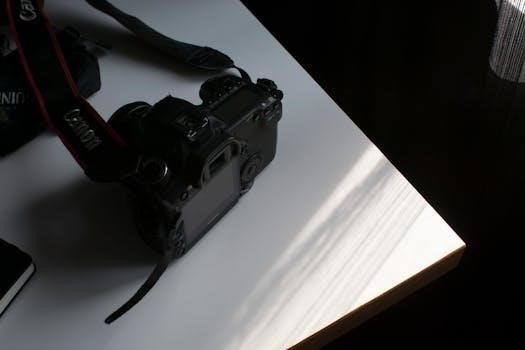Canon EOS Rebel T1i Manual⁚ A Comprehensive Guide
The Canon EOS Rebel T1i‚ also known as the 500D‚ is a capable digital SLR camera. This comprehensive guide offers resources‚ including downloadable manuals‚ to help you master its features. You will find instructions for downloading and using the manual.
The Canon EOS Rebel T1i‚ also recognized as the EOS 500D‚ is a versatile digital single-lens reflex camera designed for both novice and enthusiast photographers. Understanding its capabilities is crucial for capturing stunning images. This camera features a high-resolution CMOS sensor and a range of customizable settings.
This guide provides an overview of the camera’s key features‚ functions‚ and settings‚ designed to help you unlock its full potential. Learning to navigate the camera’s menu system and understanding the various shooting modes are essential steps. This introduction aims to provide a solid foundation for using the Rebel T1i.
The Canon EOS Rebel T1i combines user-friendly design with advanced features. Whether you’re interested in capturing portraits‚ landscapes‚ or action shots‚ this camera offers the tools you need. Familiarizing yourself with the basics will enhance your photographic journey. The instruction manual is an invaluable resource for mastering the camera.
Finding and Downloading the Manual
Accessing the Canon EOS Rebel T1i manual is essential for understanding all the camera’s features. The easiest way to obtain the manual is by visiting the official Canon website. Navigate to the support section and search for the EOS Rebel T1i or EOS 500D.
Here‚ you will find drivers‚ software‚ and crucially‚ the instruction manual in PDF format. Ensure you download the correct manual for your specific model to avoid confusion. Alternatively‚ search online using terms like “Canon EOS Rebel T1i manual PDF” to find reliable sources.
Once downloaded‚ save the manual to your computer or mobile device for easy access. The PDF format allows for convenient searching‚ printing‚ and offline viewing. Having the manual readily available ensures you can quickly reference any function or setting you’re unsure about. This will greatly improve your experience with the Canon EOS Rebel T1i.
Understanding the Camera’s Layout
Familiarizing yourself with the Canon EOS Rebel T1i’s layout is crucial for efficient operation. The camera body features various buttons‚ dials‚ and ports‚ each serving a specific function. On the top panel‚ you’ll find the mode dial‚ which allows you to select different shooting modes such as Auto‚ Manual (M)‚ and scene modes.
The shutter button‚ located near the mode dial‚ is used to take photos. The rear of the camera houses the LCD screen‚ providing a live view of the scene and displaying settings. Around the LCD screen are buttons for menu navigation‚ image playback‚ and accessing quick settings.
The lens mount on the front of the camera allows you to attach different lenses. Understanding the location and function of each control will significantly enhance your photography experience. Referring to the camera manual will provide detailed diagrams and explanations of each component‚ ensuring you can quickly adjust settings and capture the perfect shot.

Basic Camera Settings and Modes
The Canon EOS Rebel T1i offers various shooting modes‚ including Auto‚ Scene‚ and Manual (M). Understanding these modes and basic settings is essential for taking great photos. Adjusting these settings will allow you to have greater creative control.
Auto Mode and Scene Modes
The Canon EOS Rebel T1i simplifies photography with its Auto mode‚ which automatically adjusts settings for optimal results. This mode is ideal for beginners or quick snapshots where manual adjustments aren’t necessary. The camera analyzes the scene and selects appropriate settings.
Scene modes offer pre-programmed settings optimized for specific situations. These modes include Portrait‚ Landscape‚ Close-up‚ Sports‚ and Night Portrait‚ among others. Each mode adjusts parameters like aperture‚ shutter speed‚ and white balance to suit the subject;
For instance‚ Portrait mode softens the background to emphasize the subject‚ while Landscape mode prioritizes sharpness and vibrant colors. Sports mode uses a faster shutter speed to freeze motion‚ and Night Portrait combines flash with a slower shutter speed.
These modes provide a convenient way to capture quality images without needing in-depth knowledge of camera settings. They allow users to quickly adapt to various shooting environments and achieve desired effects with minimal effort. They are good for beginners to learn with.
Manual (M) Mode⁚ Gaining Full Control
The Manual (M) mode on the Canon EOS Rebel T1i unlocks complete creative control over your photography. Unlike automatic modes‚ M mode requires you to set both the aperture and shutter speed. This allows for precise adjustments to exposure and depth of field.
Aperture controls the amount of light entering the lens and affects the depth of field. A wider aperture (smaller f-number) creates a shallow depth of field‚ blurring the background. Shutter speed determines how long the sensor is exposed to light.
Understanding the relationship between aperture‚ shutter speed‚ and ISO is crucial for mastering M mode. Use the camera’s light meter as a guide to achieve proper exposure. Experiment with different combinations to achieve the desired artistic effect.
Manual mode is ideal for situations where automatic modes struggle‚ such as challenging lighting conditions or when you want to create a specific look. It requires practice and a solid understanding of photographic principles but offers unparalleled creative freedom. Taking the time to learn is worth it.

Advanced Features and Customization
Explore the Canon EOS Rebel T1i’s advanced features and customization options to fine-tune your photography. Adjust white balance for accurate colors and utilize image stabilization for sharper images. These settings enhance creative control and image quality.
White Balance Settings
Understanding white balance is crucial for achieving accurate colors in your photographs with the Canon EOS Rebel T1i. This setting corrects color casts caused by different lighting conditions‚ ensuring that whites appear white and other colors are rendered naturally. The T1i offers several preset white balance options‚ including Auto‚ Daylight‚ Shade‚ Cloudy‚ Tungsten‚ and Fluorescent. Each preset is designed for specific lighting environments‚ simplifying the process of color correction.
For more precise control‚ the T1i also features a Custom White Balance setting. This allows you to manually calibrate the camera’s white balance using a white or gray card. By taking a photo of the card under the existing lighting conditions‚ you can create a custom white balance profile that accurately reflects the color temperature of the scene. This is particularly useful in mixed lighting situations or when shooting in environments with unusual color casts. Mastering white balance settings on your Canon EOS Rebel T1i will significantly improve the overall quality and accuracy of your images.
Image Stabilization
Image stabilization (IS) is a valuable feature‚ though not built into the Canon EOS Rebel T1i body itself‚ it is available through certain Canon lenses. It minimizes blurring caused by camera shake‚ especially useful in low-light situations or when using longer focal lengths. When activated‚ the IS system compensates for slight movements of the camera‚ allowing you to capture sharper images at slower shutter speeds.
To utilize image stabilization‚ you’ll need a Canon lens with IS capabilities‚ often denoted by “IS” in the lens name (e.g.‚ EF-S 18-55mm IS). On the lens‚ you’ll find a switch to turn IS on or off. When shooting handheld‚ especially in dim lighting‚ engaging IS can make a significant difference in image sharpness. However‚ when using a tripod‚ it’s generally recommended to turn IS off‚ as the system might attempt to compensate for nonexistent movement‚ potentially leading to slight blurring. Understanding when and how to use image stabilization can greatly enhance your photography with the Canon EOS Rebel T1i.

Troubleshooting and Maintenance
Maintaining your Canon EOS Rebel T1i ensures longevity. This section addresses common problems‚ offering solutions. Learn cleaning techniques and proper storage methods. Keep your camera functioning optimally with these essential troubleshooting and maintenance tips for the Canon EOS Rebel T1i.
Common Issues and Solutions
The Canon EOS Rebel T1i‚ while a reliable camera‚ can sometimes encounter issues. One common problem is image blur‚ often caused by insufficient light or camera shake; Ensure adequate lighting or use a tripod. Image stabilization‚ if available‚ can help minimize blur. Another issue is error messages‚ which might indicate a problem with the SD card. Try a different card or format the existing one (after backing up any important files).
Battery drain can also be a concern. Ensure the battery is fully charged and avoid using the LCD screen excessively; Also‚ check that the lens is properly attached; a loose connection can cause errors. If the camera freezes‚ try removing and reinserting the battery. For more complex problems‚ consult the official Canon EOS Rebel T1i manual for detailed troubleshooting steps. Regularly updating the camera’s firmware can also resolve some issues and improve overall performance‚ so be sure to check for available updates on Canon’s support website.
Cleaning and Storage
Proper cleaning and storage are crucial for maintaining your Canon EOS Rebel T1i. Begin by regularly cleaning the camera body with a soft‚ dry cloth to remove dust and fingerprints. For the lens‚ use a lens cleaning cloth and a blower to remove particles before gently wiping the surface. Avoid using harsh chemicals or abrasive materials. The sensor should only be cleaned by a professional.
When storing your T1i‚ remove the battery to prevent corrosion. Store the camera in a cool‚ dry place away from direct sunlight and extreme temperatures. Ideally‚ use a camera bag or case to protect it from dust‚ moisture‚ and physical impact. If storing for an extended period‚ consider using silica gel packets to absorb any moisture. Regularly inspect your camera and lenses for any signs of damage or mold growth‚ addressing any issues promptly to ensure longevity and optimal performance.

Connecting to a Computer
Connecting your Canon EOS Rebel T1i to a computer allows for easy transfer of photos and videos. Refer to the instruction manual for specific steps on establishing a connection and transferring files.
Transferring Photos and Videos
Transferring photos and videos from your Canon EOS Rebel T1i to a computer is a straightforward process. Begin by connecting your camera to the computer using the provided USB cable. Ensure that the camera is powered on. Your computer should recognize the camera as a removable disk or imaging device.
Once connected‚ you can access the camera’s memory card through your computer’s file explorer. Locate the DCIM folder‚ which contains your photos and videos. From there‚ you can copy the desired files to a folder on your computer. For larger transfers‚ consider using the Canon EOS Utility software‚ available for download from the Canon website.
The EOS Utility offers additional features‚ such as remote shooting and camera settings adjustments. After transferring your files‚ safely disconnect the camera from the computer to avoid data corruption. This ensures the integrity of your cherished memories captured with your Canon Rebel T1i.